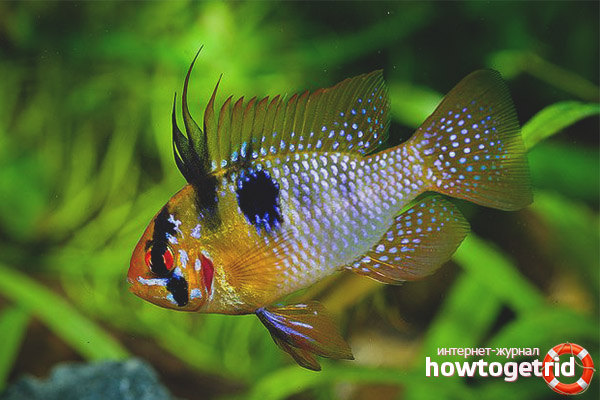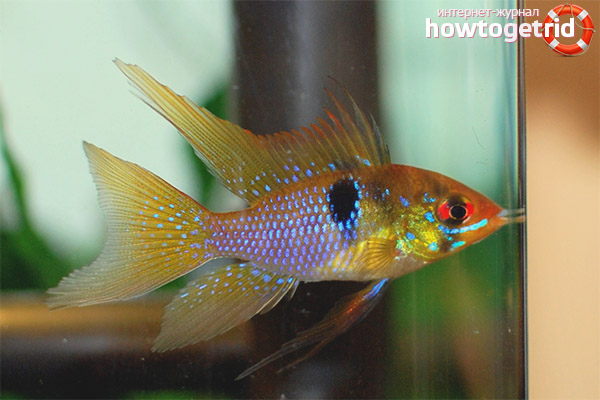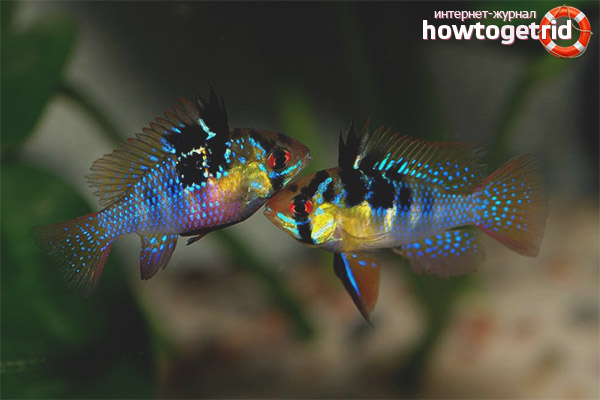The content of the article
The Latin name for the fish is the Apistogram ramirezi sounds like Mikrogeophagus Ramirezi. A whole host of other names are connected with it. It looks like a small, beautiful, fairly peaceful fish, the habitat of which is the aquarium. Her relative is a Bolivian butterfly. Despite the fact that Ramirezi was discovered much later than her relative, today it is very widespread and sold much more often. In an artificial aquarium environment, it can grow up to 5 cm. In the wild, you can find larger specimens.
There are some varieties of this fish that have been bred artificially. There are veil, neon fish, gold, other representatives. But not only the variety of forms characterized by this amazing fish. She also has a whole host of different names. Some aquarists are often confused in these names, although, despite the variety of names, they mean the same species. Between themselves, they differ in color and body shape.
Intrauterine crossing and blood mixing led to the fact that the fish gradually degenerated. Various variations of it appeared, such as the electric blue neon or the gold ramezeri. Of course, they all have a brighter color, but at the same time they acquire weakened immunity, which entails frequent diseases. Sometimes those who are breeding fish for sale, use hormone injections for greater attractiveness. Therefore, when buying, you should be very careful and it is better to purchase it from familiar sellers. Otherwise, such a fish stuffed with hormones will lose all its attractiveness and die after some time.
Chromis butterfly is less aggressive compared to other cyclides. At the same time, it is more capricious, and its content is characterized by increased complexity. Ramerizi, since it has a peace-loving character, may well be kept together with other fish, whose habitat is a common aquarium. It will coexist quite peacefully, for example, with goupia. Sometimes, however, individual signs of aggression are observed. But this can be more attributed to attempts to scare than to attack. Yes, and this can only occur when someone shamelessly entered their territory.
Ramirezi in nature
Fish loves places where there is still water. It does not tolerate a strong current, but it is quite comfortable in waters with a weak current. Chooses places where there is a sandy or silty bottom and plenty of vegetation. For food, it burrows itself into the ground and seeks out food for its food there. Sometimes it can eat, going to the surface of the water surface.
general description
Oval contours of the body with high fins characterize the appearance of the fish. In males, they have a more pointed appearance. Representatives of females are smaller in size than males. When aquarium content can grow up to 5 cm. Proper maintenance ensures the survival of the fish for 4 years.
The fish has a rather pronounced external attractiveness. The yellow head has red eyes.The body itself casts blue with a purple tint. The body has a black spot arrangement. Fins with bright, distinct color. Different forms have a wide variation in color. Often unscrupulous sellers use hormones in the fish feed. From this, colors become even more saturated. But, having acquired such an instance, it can be noted that the brightness of the color will quickly disappear, and the fish itself will become plain-looking.
Complexity of content

If you want to contain this particular type of fish, a butterfly will be the best option. The small fish is peaceful in nature and is able to consume various feeds. It does not show particular demands on the characteristics of water parameters. However, she is very sensitive to their change. The fish adapts well to existing conditions. Breeding is not particularly difficult, but growing fry is fraught with certain difficulties.
Fact! At present, representatives of this species are very weak, and therefore often die during the first year after acquisition.
In all likelihood, the reason for poor health lies in the fact that blood has not been updated for a long time, the body simply weakened. A certain imprint is imposed by their cultivation on farms in Asia. It is contained in conditions of elevated temperatures of the order of 30 degrees. For cultivation, only atmospheric precipitation water is used.
Feeding
In the wild, the fish uses plants for food. Small representatives of the kingdom of insects are also used. To find them, she buries herself in the ground. While in the aquarium, bloodworms, artemia, tubule, and other feeds are used for food. Feeding is carried out three times a day. At one time they give a small portion. The fish is extremely timid. Control is required so that her restless neighbors do not interfere with nutrition.
Content Rules
The capacity of the aquarium should be at least 70 liters. Fish require clean water, which contains a large amount of oxygen. Better if there is a slight current. Water should change every week. It is also required to blow through the soil. The fish lives mainly at the bottom. If the soil is not blown, increased ammonia may accumulate, and this will certainly affect the health of the fish. It will be great if there is the possibility of weekly measurements of the content of ammonia in water. Use both an external and an internal filter. The latter option is more preferred.
For the soil, it is necessary to use sand or fine gravel. Do not forget that the butterfly loves to rummage in the ground. The decoration of the aquarium should be done with the presence of a style typical of South America. It would be appropriate to use pots, snags, dense bushes. You can use fallen leaves from the trees. All this is necessary to maximize the imitation of wildlife.
Fish do not tolerate bright color. Therefore, water should be plants. Ideal for maintenance will be a temperature in the range from 24 to 28 degrees. pH should not be lower than 6.0, but not higher than 7.5.
Neighborhood with other fish representatives
It is quite acceptable if the butterfly is kept in a common aquarium, where there are peaceful medium-sized fish. As for herself, she can easily get along with any fish, but she can be offended. They can be adjacent to various viviparous representatives. This applies to guppies, swordsmen, pecilia, and other representatives. May be shared with large shrimp. Their butterfly will not touch, but small representatives may well be considered fodder.
Butterflies live alone and in pairs. To keep several pairs, the aquarium must be spacious enough in volume. Cichlid is a fish that prefers to observe the principle of territoriality.If one pair is acquired, this does not mean that spawning will take place. For breeding purposes, at least a dozen pairs must be purchased. In this case, it is possible to choose a partner.
Distinctive Gender
The female has a brighter abdomen. It is orange or scarlet. The male is larger in size. Their body is equipped with a more pointed fin shape.
Breeding
Being in the wild, fish bind in pairs. They are stable. In spawning, the female is able to lay 150-200 eggs at a time. As for the aquarium, to obtain offspring acquire 6-10 pairs of juveniles. They grow together, and then carry out the choice of a partner. If a pair is acquired, then it is not a fact that spawning will take place.
The place of laying eggs is the surface of smooth stones or wide leaves. This happens, as a rule, in the evening at a temperature of 25-28 degrees. To do this, they choose a quiet place so that no one bothers them. During stress, fish can eat caviar. Then the parents are removed from the aquarium and raise the fry on their own. Before laying eggs on a stone, a couple spends a lot of time to clean its surface. At one time, a female is able to lay 150-200 pieces of eggs, and the male is engaged in their fertilization.
Female and male in every possible way protect eggs. To this end, they fan its fins. At these moments, the fish are particularly beautiful. After the deposition of eggs, larvae gradually begin to hatch. After some time, the fry can swim independently. The female tries to put the fry out of the reach of strangers. Sometimes the male attempts to attack the female. Then the male should be dropped off. For some pairs, a common flock is divided into equal groups. But the male takes care of everyone without exception. He is not characterized by any selectivity.
The fry are very sensitive to the parameters of the water in which they are located. Stable maintenance of a certain temperature is required. Water must always be clean and free from impurities. Protection of male fry lasts for three weeks. Then he stops doing it. At this time, the male is required to jig.
Water needs to be changed every day, but in a volume of not more than 10% of the total. When the male is deposited, the volume of replaced water is increased to 30%. The added water is necessarily passed through osmosis.
Independent raising of fish fry Apistogram Ramizeri is not an easy task at all. It takes a lot of effort and effort to create optimal conditions for the growth and development of this representative of the ichthyofauna.
Video: Ramirezi apistogram - keeping and breeding











Submit